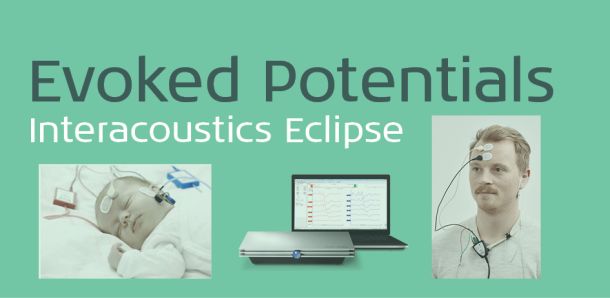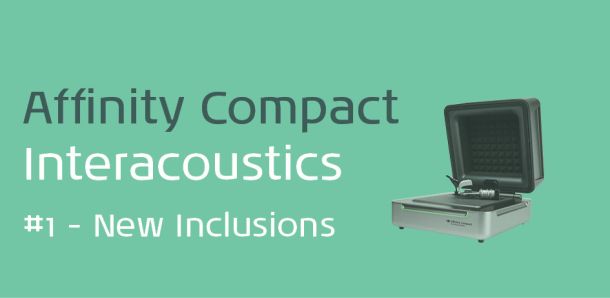We hope you have all had a wonderful 2022. It has been great to get back to visiting customers and attending work events after the last couple of years. This year we have focused our blogs on the Eclipse (Electrophysiological EP testing), ending with 2 weeks of Eclipse events along the east coast of Australia in October.
If you would like to learn more about EP tests, please refer to our website. For our last blog of the year, we thought we would cover 10 features that make the Eclipse unique.
1. CE-Chirp
CE-Chirp® is a family of short duration acoustic stimuli which can be used in evoked potential testing. CE-Chirp was designed to increase the amplitude of the wave V of ABR (auditory brainstem response) and provide shorter test times. Therefore, it is mainly used for testing hearing thresholds in infants. The CE-Chirp® provides a more synchronous neural firing of the cochlea and compensates for the travel time in the cochlea by presenting the low frequency energy of the stimulus before the high frequency.

In the study by Elberling and Don (2008), it was demonstrated that the CE-Chirp® ABR is up to 1.5-2.0 times larger than the corresponding click ABR in normal-hearing subjects. Having a larger ABR would also help with improving SNR.
Since the development of the traditional CE-Chirp® in 2007, there has been a lot of research on this stimulus and it has been further optimised. In 2015 the CE-Chirp LS was released. LS stands for level specific. The stimulus was optimized for each intensity. This means that CE-Chirp® family of stimuli now has twenty CE-Chirp LS Stimuli in addition to 4 frequency specific NB CE-Chirp LS.
2. Bayesian weighting
The Bayesian Weighting feature allocates a weighting for each response (sweep). It can be particularly useful if the EEG noise is changing during an ABR. For example, when patients are moving during a test. Sweeps with minimal noise are given a higher weighting than sweeps with more noise. They contribute to the average waveform depending on the weighting that they have been given. This means fewer sweeps are being rejected.
With Bayesian weighting when the patient moves, the residual noise does not increase, it stays the same, and then continues to decrease once the patient is settled. A better quality waveform is therefore formed with Bayesian weighted activated compared to traditional averaging of sweeps, as demonstrated by Don and Elberling (1994).
3. FMP
FMP is a statistical analysis of the ABR. The Response Confidence is a measure of a true response being present.

FMP compares the response amplitude to residual noise to provide a confidence level or detection rate. Lower noise or larger response amplitude will drive the FMP up (indicated by the red line). When there is no response, the response amplitude will not rise above the residual noise, therefore the FMP value and the Response Confidence will remain low. FMP acts as a quality metre for the waveform which relies on statistical data.
4. Modules on Eclipse
There are two ABR models available on the Eclipse; EP15 and EP25.
EP15 has the following tests: threshold and neurological ABR and eABR. There is also the option to add the CE-Chirp stimulus and EcochG/CM tests.
EP25 features all the tests available in the EP15 and also ECochG . EP25 also has the middle and late latency tests: AMLR, ALLR & P300/MMN. You can also add the Research module to the EP25.
Both the EP15 and EP25 can also have the following individual modules added:
- OAE (DP and TE)
- VEMP (cVEMP and oVEMP)
- ASSR
- ABRIS (screening ABR)
Any of the Eclipse modules can be purchased by themselves and in combination.
5. Research Module
The research module allows you to export averaged curves and also to log each sweep. This allows you to analyse the recordings in Excel or Matlab further detail particularly for those conducting research studies in EP. Further to this, the research module allows you to upload sound files, for example speech sounds, for ALR assessment. These stimuli, and the traditional stimuli can also be presented via a loud speaker for assessment of aided corticals.
6. B-81 tranducer
In the past the B-71 bone conductor was used with the Eclipse, however, now we have the B-81. The B-81 bone conductor is the recommended transducer for testing oVEMPs. The B-81 can be calibrated to test levels of 75 dB nHL with 250-4000 Hz tonebursts.
The B81 is an approved medical device and can be easily calibrated to standard electrophysiological set-ups.
The highest oVEMP response rates were obtained with the B81 on the mastoid (83–92%), The Mini-Shaker elicited lower response rates (65%) compared to results from the literature without coupling force control and compared to ACS (78–87%). Fröhlich, L., Wilke, M., Plontke, S.K. et al 2021
7. EMG monitor with cVEMP

The VEMP monitor display in the cVEMP protocol, shows the ongoing EMG contraction/activity during testing. The two black vertical bars on the display show the contraction range for testing. If you activate “EMG controlled Stimulus” in the protocol set up, when the patient’s EMG contraction is within the range, the bar will turn green. The stimulus will then be presented and responses are recorded. When the EMG contraction is above or below the optimal range, the bar will appear in red (for right ear) and blue (for left ear). If you have a patient who has weak or very strong muscle contraction, you can adjust the contraction range, by dragging the black bars with the computer mouse.
Once VEMP is complete you can then apply “EMG scaling” to the curves obtained. This scales the left and right waveforms depending on the ongoing EMG contraction during testing. This is a more accurate comparison of the two sides, especially when one side of the neck is weaker than the other.
8. Customisable protocols
There is a lot of flexibility with customising protocols for all the tests in the Eclipse. This is performed in the System Set up Menu where you can adjust current protocols or create new ones. You can change the following :
- Stimulus properties – type, rate, polarity, rise/fall time
- Filter properties – low and high pass filters, display filters
- Display properties – how you prefer your waveforms displayed; split screen, display polarity etc.
- Recording properties – stop criteria, when to start recording and recording range (in ms) and noise rejection level
You may also prefer to adjust a protocol temporarily for a given patient. This can be performed on the main screen “Set up”. Anything changed here will default back to previous settings after the test is complete.
9. Binaural ASSR testing
The Eclipse tests ASSR with both ears simultaneously and all 4 frequencies at once in each ear (0.5, 1, 2, 4kHz). It is a test used for performing a threshold assessment.
Unlike auditory brainstem response (ABR) which looks at amplitude and latency of the response in the time domain, ASSR looks at amplitudes and phase in the frequency domain. Responses are detected using a statistic-based algorithm to determine if a response is present or not. It therefore takes out the subjective aspect of analysing a response.
While the ASSR test is running, you can select the next dB level for each frequency as the patient passes the previous (louder) level. This availability along with testing all frequencies at once, ensures the test is quicker to perform than ABR. Sininger et al (2018) found that the test time was significantly lower when using ASSR compared to when using ABR.
As the ASSR test is running, the ASSR software converts the results into an estimated audiogram for both ears which can be used for hearing aid fittings if needed.
10. IA OAE Suite
The Eclipse also has the option of an OAE module which includes Clinical DP and Clinical TE OAE tests. The frequency range for Clinical DPOAE is 0.5-10kHz, and the frequency range for Clinical TEOAE is 0.5-5.5kHz.
The Eclipse OAE module features:
- Lightweight probe with low internal noise
- Probe check indicator for correct placement
- Historic overlay for test comparison
- Test summary providing a quick overview of results
- Protocol settings for pass/refer results which can be used for screening
- Weighted averaging improving data quality and limiting the test time
Below is an example of the test screen for each type of OAE.
DPOAE

TEOAE

References
Don, M., & Elberling, C. (1994). Evaluating residual background noise in human auditory brainstem responses. Journal of the Acoustical Society of America, 96, 2746–2757
Elberling, C., and Don, M. (2008). “Auditory brainstem responses to a chirp stimulus designed from derived-band latencies in normal-hearing subjects,” J. Acoust. Soc. Am. 124, 3022–3037.
Fröhlich, L., Wilke, M., Plontke, S.K. et al. Influence of bone conduction transducer type and placement on ocular and cervical vestibular evoked myogenic potentials. Sci Rep 11, 8500 (2021). For article access Click Here.
Yvonne S. Sininger, Lisa L. Hunter, Deborah Hayes, Patricia A. Roush and Kristin M. Uhler (2018) Evaluation of Speed and Accuracy of Next-Generation Auditory Steady State Response and Auditory Brainstem Response Audiometry in Children with Normal Hearing and Hearing Loss Ear and Hearing 39(6): 1207–1223.
______________________________________________________________
We hope you have enjoyed our Eclipse 2022 blog series. Stay tuned for Affinity Compact blog series in 2023.
Latest Articles

ABR Interacoustics Eclipse

ASSR and ABR Comparison on the Eclipse
